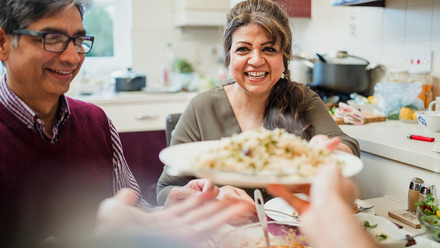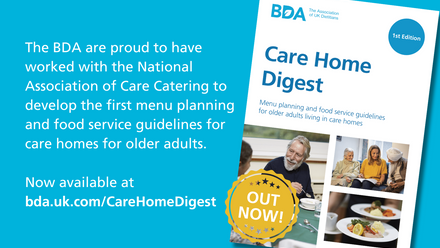This fact sheet explains what cholesterol is and how eating better can help to lower your cholesterol if it is too high.
What is cholesterol?
Cholesterol is a fatty substance found in your blood. It is produced naturally in the liver. We need some cholesterol to stay healthy. It is used to make certain hormones and vitamin D, as well as bile acids, which help digest and absorb dietary fat.
Your blood carries cholesterol around your body on proteins called lipoproteins. There are two main types:
- High density lipoproteins (HDL cholesterol) take cholesterol you don’t need back to the liver to be broken down and passed out of the body. It’s often known as ‘good’ cholesterol as it removes cholesterol from the blood.
- Non-high-density lipoproteins (Non-HDL cholesterol) take cholesterol from the liver to the cells around the body. It’s often known as ‘bad’ cholesterol because when there is too much, it can build up in your arteries. This can cause them to become narrowed or blocked and increase your risk of having a heart attack or stroke.
What causes high cholesterol?
Having high cholesterol is mainly caused by:
- eating foods high in saturated fat
- not being active enough
- smoking
- having too much body fat, especially around your middle
It can also run in families. Changing what you eat, being more active, and stopping smoking can help get your cholesterol back to a healthy level.
Lowering your cholesterol with diet
A few small changes to your diet can make a big difference to your cholesterol level.

1. Choose healthier fats
To help lower your cholesterol you don’t need to avoid fats altogether. You should cut down on foods high in saturated fat and replace them with food high in unsaturated fat like vegetable oils (olive, rapeseed and sunflower oil), nuts, seeds, avocado and oily fish (see Table 1).
Table 1: main food sources of dietary fats
| Saturated fat | Unsaturated fat | |
|
Full-fat dairy products Fatty meat and meat products such as pasties, sausages and pies Biscuits, cakes and pastries Butter, cream, ghee and lard Coconut and palm oils |
Polyunsaturated fat | Monounsaturated fat |
|
Oily fish Sunflower, soya, corn or safflower oils and spreads Flax, pumpkin and sesame seeds Walnuts |
Olive and rapeseed oil Avocado Nuts such as almonds, cashews, and hazelnuts |
|
Swap saturated fats for unsaturated fats. Try these smart swaps to help cut back on saturated fat.
Table 2
|
Eat less |
Smart swap |
|
Creamy or cheesy sauces |
Tomato or vegetable-based sauces |
|
Fatty meat products such as sausages, burgers, pate, salami, meat pies and pasties |
Lean cuts of meat and mince Chicken and turkey with the skin removed Fish especially oily fish such as mackerel, sardines, salmon Vegetarian options like lentils, chickpeas, soya |
|
Crisps and chocolate |
Fresh or dried fruit or a handful of unsalted nuts and seeds |
|
Full-fat milk, cheese, cream and yoghurt |
Lower fat dairy foods such as 1% milk, reduced fat cheddar, low-fat yoghurt |
|
Lard, dripping, ghee, butter and coconut oil |
Vegetable oils - such as olive, sunflower, soya or rapeseed oil and their spreads |
2. Look at food labels
Compare labels and choose foods with green or amber labels for ‘saturates’. Foods are high (red) in saturated fat if they contain more than 5g of saturates per 100g. Foods containing 1.5g or less per 100g are low (green) in saturated fat. Some healthy foods that are high in fat like oily fish, nuts and oils, may be red for saturated fat. This is okay, as they contain more of the healthy unsaturated fat.
3. Eat more high fibre foods
Eating plenty of fibre helps lower your risk of heart disease and some high fibre foods can help lower your cholesterol. To make sure you get enough fibre:
- Aim for five portions of fruit and vegetables a day
- Switch to wholegrain varieties of bread, cereals, pasta and rice
- Choose other high fibre foods such as pulses (lentils, beans, chickpeas), oats, unsalted nuts and seeds
What about plant stanols or sterols products?
If you have high cholesterol, using foods with added plant stanols and sterols has been shown to help to lower cholesterol levels. You need to eat 1.5-3g of plant stanols or sterols, in combination with a healthy diet, to see a reduction in cholesterol.
You can get this from fortified foods such as mini drinks, spreads, milk and yoghurts from both branded and supermarket own label products. If you decide to use these products, follow guidelines on the packet to get the right amount. However, they are not a substitute for healthy diet nor a replacement for cholesterol lowering medication. And if you don’t have high cholesterol, these products are not recommended. Find out more in our Stanols and Sterols fact sheet.
Dietary cholesterol – don’t get confused!
Some foods naturally contain dietary cholesterol, but don’t make a big difference to the cholesterol in your blood. These are foods like eggs, some shellfish such as prawns and crab and offal such as liver, liver pate and kidney. They are low in saturated fat and so are fine to eat as part of a healthy diet. Only cut down on these foods if your doctor or a dietitian has advised you to. To lower cholesterol, it’s more important to cut down on the amount of saturated fat you eat.
Top tips
- Cholesterol is a fatty substance found in your blood. There are two main types: HDL- cholesterol or ‘good’ cholesterol and non-HDL cholesterol or ‘bad’ cholesterol.
- Too much non-HDL cholesterol can cause your arteries to become blocked. This increases your risk of having a heart attack or stroke.
- A healthy balanced diet, being physically active, stopping smoking and keeping a healthy weight and shape can all help to lower your cholesterol.
- Replace foods containing saturated fats with those that contain polyunsaturated and monounsaturated fats. You can do this by choosing healthy fats such as olive or rapeseed oil, nuts, seeds, fish and avocado.
- Increase your fibre intake by choosing vegetables, fruits, wholegrains, pulses, nuts and seeds every day.
Source(s)
- BHF: High Cholesterol – Causes, Symptoms and Treatment. Accessed 22/4/2021 https://www.bhf.org.uk/informationsupport/risk-factors/high-cholesterol
- Cardiovascular disease: risk assessment and reduction, including lipid modification CG 18 NICE 2014. Accessed 22/04/2021 https://www.nice.org.uk/guidance/cg181/chapter/1-Recommendations#lifestyle-modifications-for-the-primary-and-secondary-prevention-of-cvd
- Heart UK The Cholesterol Charity - Plant Stanols and Sterols, Accessed 22/04/2021 https://www.heartuk.org.uk/healthy-living/cholesterol-lowering-foods-1
- NHS Choices: Lower your cholesterol. Accessed 22/04/2021 https://www.nhs.uk/live-well/healthy-body/lower-your-cholesterol/







